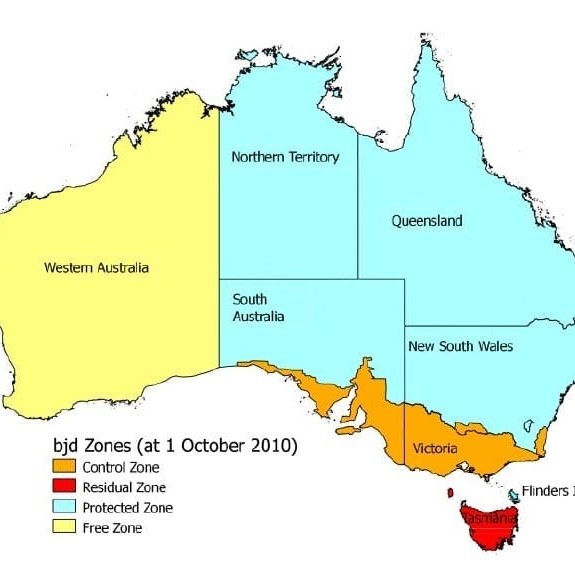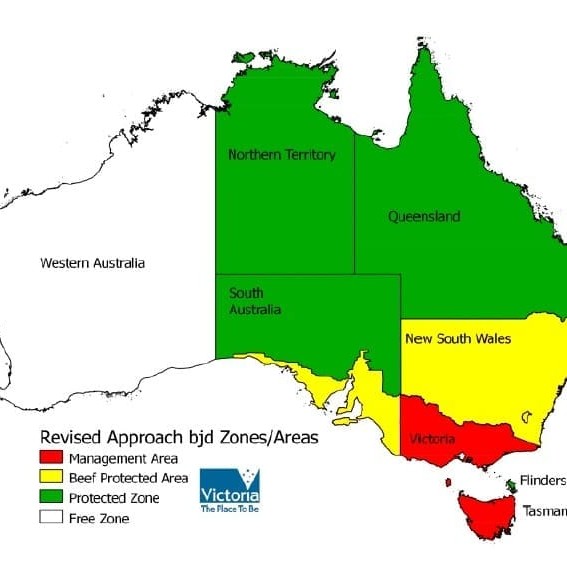 New South Wales will be the main focus for changes in Australia’s Bovine Johne’s Disease management plan, due to be enacted from July 1.
New South Wales will be the main focus for changes in Australia’s Bovine Johne’s Disease management plan, due to be enacted from July 1.
A summit involving a range of stakeholders was held in Sydney before Christmas to discuss the future management of BJD, which have now been agreed to nationally. The proposed plan was prepared by the BJD Technical Advisory Group of Animal Health Committee.
Under the revised management plan (refer to colour-coded maps illustrating current arrangements and how they will change after July 1):
- Western Australian will remain as a Free Zone
- Queensland, NT and the pastoral zone of South Australia will remain as a Protected Zone
- All of NSW and the non-pastoral zone of South Australia will become a Beef Protected Area. This means there will be no differing Zones within NSW.
- Victoria and Tasmania will become a Management Area.
The main State affected by these changes is NSW where the three small parts of the State which are currently Control Zones based on their high dairy population are no longer zoned differently to the rest of the State.
A ‘compartmentalisation’ approach has been taken for NSW where dairy herds and beef herds will in future be managed differently due to their different risk profiles.
 The non-pastoral zone of SA will also use a compartmentalisation approach, and as a result is zoned the same as NSW.
The non-pastoral zone of SA will also use a compartmentalisation approach, and as a result is zoned the same as NSW.
The National Johne’s Disease Control Program (NJDCP) was initiated in 1995 by the jurisdictions and the cattle and goat industries under the direction of the National Farmers Federation and has been managed as a special program by Animal Health Australia since 1997. The National BJD Strategic Plan was activated in 2003. The current plan lapsed on December 31, with the new plan, activate from July 1 this year, likely to be enforced until 2020.
The strategic framework behind the new plan recognises that BJD is endemic in the dairy sector in south eastern Australia, but that the prevalence of BJD in the beef sector in the same region remains relatively low.
A discussion paper covering the reasoning behind the new plan suggests that to appropriately apply the differing geographical and sectoral risks, costs and benefits of BJD management, the strategic framework also provides:
- A risk-based trading approach for dairy cattle within Victoria, Tasmania, New South Wales and South Australia.
- A Central Beef Protected Area in NSW and the southern part of SA, where the beef sector is protected by regulation and a risk-based trading approach operates for dairy cattle.
- A South East Management Area within Victoria and Tasmania where the beef sector and alpaca are protected by encouraging voluntary biosecurity and a risk based trading approach operates.
- Financial and non-financial assistance provided by the beef industry to affected beef producers in each zone or area.
- Free Zone, Protected Zone and Central Beef Protected Area are established based on cumulative surveillance with ongoing surveillance and monitoring to maintain the zone or area.
- Appropriate risk-based assurance for beef cattle movements into the Central Beef Protected Area, Protected Zone and Free Zone.
From the beef industry’s perspective, the rationale behind a national approach to the management of BJD includes a number of points:
- Australia is in a favourable situation in comparison to other developed meat and livestock producing countries, as endemic BJD is restricted to south-eastern Australia, predominantly in dairy herds.
- The beef cattle industry wishes to retain maximum domestic market access without compromising the free status of the majority of Australian herds and possibly jeopardising international market access for live cattle in particular.
- Producers in Free and Protected Zones wish to maintain their favourable situation in order to retain market access (without testing costs) and, in some cases, to avoid the regulatory disease control programs that would be required if BJD occurred in their zones. Lower status zones and areas have pathways to attain a higher status.
- Producers with infected herds want pathways to ease the stigma of known infection and enable progression towards regaining market access for cattle and land without price penalties.
- Producers in the Management Area who meet necessary biosecurity requirements want access to marketing pathways through Beef Only categorisation.
A national approach to BJD benefits all stakeholders by reducing losses resulting from restrictions of market access and movement controls; the effects on asset values; economic consequences from mortality and production losses; the effect on farm management options; and the potential for consumer and health concerns into the future.
Click on the maps below for a clearer view
